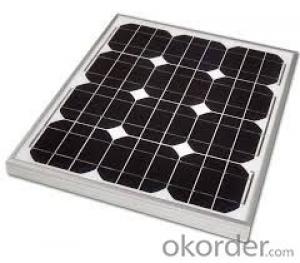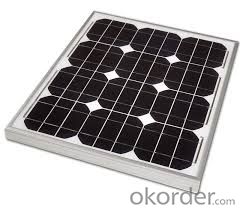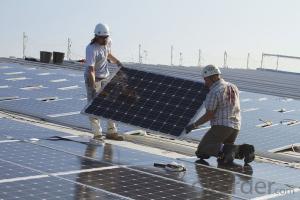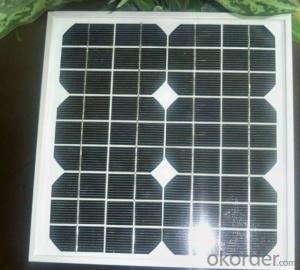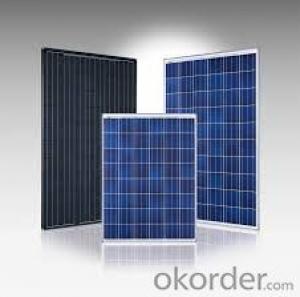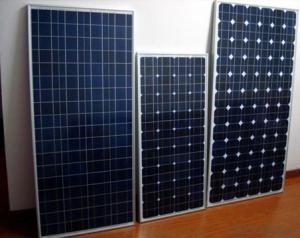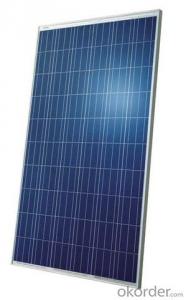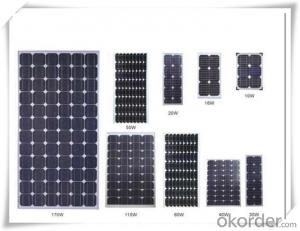Blue Sun Solar Panels - Factory Direct Small Monocrystalline Solar Panel CNBM
- Loading Port:
- Qingdao
- Payment Terms:
- TT OR LC
- Min Order Qty:
- 10 set
- Supply Capability:
- 300000 set/month
OKorder Service Pledge
OKorder Financial Service
You Might Also Like
Monocrystalline Solar Panel with 160W
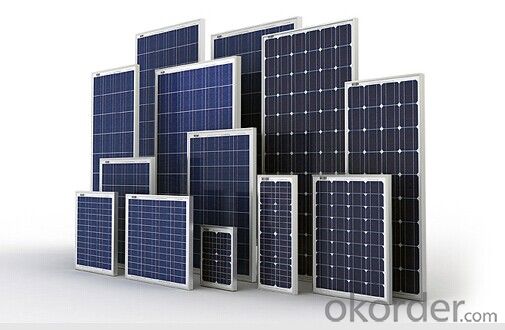
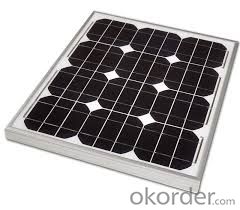
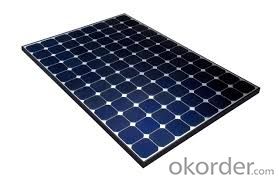
Monocrystalline Solar Modules
We offers a range of small, medium and large monocrystalline solar modules, designed for a range of requirements.
Specifications:
Tolerance | +/- 3% |
Cell | Monocrystalline silicon solar cells |
N0. of Cells | 72 (12 x 6) |
Dimension of Modules (mm) | 1581 x 809 x 40 |
Weight (kg) | 15.5 |
Limits:
Operating Temperature | -40~+85? |
Storage Temperature | -40~+85? |
Maximum System Voltage | 1000 VDC max. |
Hail Impact | Diameter of 28mm with impact speed of 86km/h |
Temperature and Coefficients:
NOCT | 48C+/-2? |
Voltage temperature coefficient (%/K) | -0.34 |
Current temperature coefficient (%/K) | 0.09 |
Power temperature coefficient (%/K) | -0.37 |
Characteristics:
Model: | SGM-160D | SGM-165D | SGM-170D |
Max-power voltage Vmp (V) | 34.5 | 35.4 | 35.8 |
Max-power current Imp (A) | 4.64 | 4.66 | 4.75 |
Open-circuit voltage Voc (V) | 41.75 | 43.6 | 43.32 |
Short-Circuit Current Isc (A) | 5.32 | 5.08 | 5.38 |
Max-power Pm(W) | 160 | 165 | 170 |
Model: | SGM-175D | SGM-180D | SGM-185D |
Max-power voltage Vmp (V) | 36.1 | 36.2 | 36.2 |
Max-power current Imp (A) | 4.85 | 4.97 | 5.11 |
Open-circuit voltage Voc (V) | 43.68 | 43.8 | 44.8 |
Short-Circuit Current Isc (A) | 5.49 | 5.48 | 5.51 |
Max-power Pm(W) | 175 | 180 | 185 |
STC: Irradiance 1000W/m2, Module temperature 25?, AM=1.5
Monocrystalline Solar Panels Specifications Range
Maximum Power (Pm) | Dimension | Weight | Operating Voltage (Vmp) | Operating Current (Imp) | Open Circuit Voltage (Voc) | Short Circuit Current (Isc) |
3W | 158x241x25mm | 0.5kg | 8.5V | 0.36A | 10.5V | 0.4A |
4W | 308x166x25mm | 0.77kg | 8.5V | 0.47A | 10.5V | 0.54A |
4W | 308.x166x25mm | 0.77kg | 16.8V | 0.24A | 21V | 0.27A |
5W | 296x215x25mm | 0.3kg | 16.8V | 0.48a | 21V | 0.54A |
10W | 286x406x25mm | 1.5kg | 16.8V | 0.59A | 21V | 0.66A |
12W | 286x406x25mm | 1.5kg | 16.8V | 0.71A | 21V | 0.8A |
14W | 286x541x25mm | 2kg | 16.8V | 0.83A | 21V | 0.96A |
16W | 286x541x25mm | 2kg | 17.2V | 0.93A | 21.5V | 0.99A |
18W | 296x541x25mm | 2.4kg | 18.8V | 1.07A | 21V | 1.2A |
20W | 296x641x25mm | 2.4kg | 17.2V | 1.15A | 21.5V | 1.24A |
24W | 541x451x25mm | 3.15kg | 16.8V | 1.14A | 21V | 1.56A |
26W | 541x451x25mm | 3.15kg | 17.2V | 1.51A | 21.5V | 1.63A |
30W | 296x966x25mm | 3.85kg | 16.8V | 1.78A | 21V | 2.03A |
36W | 541x641x35mm | 4.7kg | 16.8V | 2.14a | 21V | 2.4A |
40W | 541x641x35mm | 4.7kg | 17.2V | 2.33A | 21.5V | 2.5A |
55W | 1057x457x35mm | 6.6kg | 17.6V | 3.12A | 21.6V | 3.3A |
70W | 546x1196x35mm | 8.5kg | 16.8V | 4.15A | 21V | 4.7A |
75W | 546x1196x35mm | 8.5kg | 17.2V | 4.36A | 21.5V | 4.8A |
80W | 546x1196x35mm | 8.5kg | 17.6V | 4.55A | 21.6V | 4.9A |
110W | 1066x811x40mm | 11.8kg | 17.6V | 6.25A | 21.6V | 6.6A |
150W | 1066x811x40mm | 14kg | 34.4V | 4.36A | 43.2V | 4.7A |
- Q: Given that I am going to purchase a solar panel to charge my cell phones and other gadgets, I would like to know what the ammount of power produced by a 6 Watt solar panel is under regular circumstances. (IE partial sun, full sun, cloudy)
- That site tells you somewhat about the cost of solar panels and their MAXIMUM output. Now some who have these panels claim output, in daily terms, 8 times as great as maximum output, which says they are counting on 8 hours of effective sunlight. In California Desert that is sound. You will discover that Ontario Power grid is planning for 3 hours to 4 hours of maximum output . Based on that 3 to 4 hours of maximum output, it would take close to 20 years to recover your cost at the price Ontario pays for solar power. The deal locks you in so that you can not get more money as electricity prices go up, and do not lose if electricity prices go down over that 20 years.
- Q: If you want to instal solar panels...how often do you have to replace them?
- Expect a water heating panel to last about the same as a water heater, 0 to 5 years. Actually, my brother's system is coming up on 5 years, and is not giving trouble yet, so maybe technology has advanced. I have actually never personally known of anyone replacing a solar electric panel due to wear-out. I have heard of occasional replacements due to accidents, including natural disasters like lightning strikes. And one brand of panels had manufacturing defects around the year 2000, but that manufacturer owned up and replaced those free of charge to their customers. A standard warranty on a solar electric panel nowadays is 25 years.
- Q: A few months ago my dad said something about getting solar panels, and how green they were. I was just wondering if there were any companies that sold them and if they would actually make a big difference.
- The okorder /
- Q: Are there any fire hazards associated with solar panels?
- Yes, there are potential fire hazards associated with solar panels, although they are relatively rare. These hazards can occur due to faulty installation, wiring issues, or manufacturing defects. However, with proper installation, regular maintenance, and adherence to safety regulations, the risk of fire can be minimized.
- Q: I am looking to buy a solar panel.What does it mean when in the title it says 200 watts, or 50 watts?
- It's okorder / for more details.
- Q: Do solar panels work at night?
- No, solar panels do not work at night as they rely on sunlight to generate electricity.
- Q: The colder a solar panel gets the more efficient it seems to be. As the panel warms, it loses some efficiency. Why is this so? Please explain in a way you would expect a high school kid to understand it, as I am a high-schooler and i have to explain this to other high-schoolers.
- Absolutely temperature matters. So what do higher temperatures do to solar photovoltaic panels? As temperatures rise, the efficiency of solar panels decreases. Heat causes electrical resistance to the flow of electrons. On days where the temperature is more than 75 degrees, the electrical resistance makes the voltage fall thereby producing less kilowatts per hour. Your roof is much hotter than temperatures on the ground. That’s why solar panels are not mounted flat to a roof. There’s usually a few inches of spaces between the panels and roof so air flow can easily pass through and cool the panels down. There are some photovoltaic panels that are designed specifically to operate in hotter temperatures. These panels have a higher temperature coefficient. This is especially important in high heat climates like Arizona or New Mexico, but probably wouldn’t make too much of a difference in New England (except maybe this year). If someone lives in one of these areas, they should speak to a solar installer to make sure they are using they right equipment for their region. Please note: Solar thermal panels used to heat water can withstand high temperatures without any degradation. In fact, hotter temperatures would actually be better for these types of modules.
- Q: i've heard environmentalists like ed begley jr use the phrase quot;peak shaving hourswhen talking about solar energy.what does that phrase mean, please?thank you to all who respond.
- You okorder /... This is known as 'Grid-Tied' Solar in the open market.
- Q: I was told by a veteran that jcpl had a program that installs free solar systems for disabled vets.If this is true who do i contact?
- It varies from state to state.
- Q: How much roof space is needed for solar panels?
- The amount of roof space needed for solar panels varies depending on several factors such as the size and type of panels, the energy requirements of the property, and the efficiency of the panels. However, as a general rule of thumb, a typical 1 kW solar panel system requires around 100 square feet of roof space.
Send your message to us
Blue Sun Solar Panels - Factory Direct Small Monocrystalline Solar Panel CNBM
- Loading Port:
- Qingdao
- Payment Terms:
- TT OR LC
- Min Order Qty:
- 10 set
- Supply Capability:
- 300000 set/month
OKorder Service Pledge
OKorder Financial Service
Similar products
Hot products
Hot Searches
Related keywords
